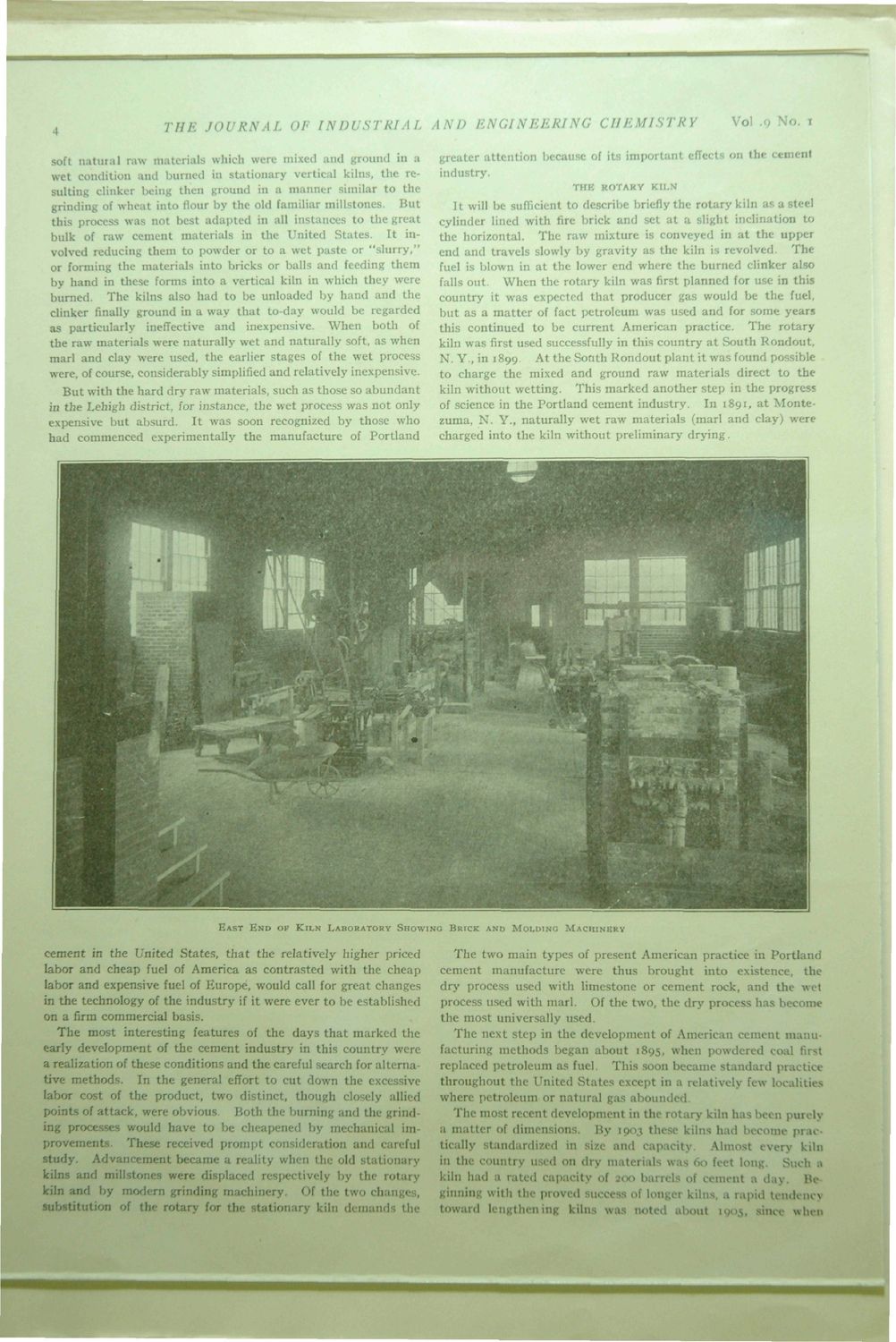| |
| |
Caption: Dedication - Ceramic Engineering - Journal Article
This is a reduced-resolution page image for fast online browsing.

EXTRACTED TEXT FROM PAGE:
THE JOURNAL OF INDUSTRIAL AND ENGINEERING CHEMISTRY Vol .0 No. 1 soft natural raw materials which were mixed and ground in a wet condition and burned in stationary vertical kilns, the resulting clinker being then ground in a manner similar to the grinding of wheat into flour by the old familiar millstones. But this process was not best adapted in all instances to the great bulk of raw cement materials in the United States. It involved reducing them to powder or to a wet paste or "slurry," or forming the materials into bricks or balls and feeding them by hand in these forms into a vertical kiln in which they were burned. The kilns also had to be unloaded by hand and the clinker finally ground in a way that to-day would be regarded as particularly ineffective and inexpensive. When both of the raw materials were naturally wet and naturally soft, as when marl and clay were used, the earlier stages of the wet process were, of course, considerably simplified and relatively inexpensive. But with the hard dry raw materials, such as those so abundant m the Lehigh district, for instance, the wet process was not only expensive but absurd. It was soon recognized by those who had commenced experimentally the manufacture of Portland greater attention because of its important effects on the cement industry. THE ROTARY KILN It will be sufficient to describe briefly the rotary kiln as a steel cylinder lined with fire brick and set at a slight inclination to the horizontal. The raw mixture is conveyed in at the upper end and travels slowly by gravity as the kiln is revolved. The fuel is blown in at the lower end where the burned clinker also falls out. When the rotary kiln was first planned for use in this country it was expected that producer gas would be the fuel, but as a matter of fact petroleum was used and for some years this continued to be current American practice. The rotary kiln was first used successfully in this country at South Rondout, N. Y., in 1899. At the South Rondout plant it was found possible to charge the mixed and ground raw materials direct to the kiln without wetting. This marked another step in the progress of science in the Portland cement industry. I n 1891, at Montezuma, N . Y., naturally wet raw materials (marl and clay) were charged into the kiln without preliminary drying. E A S T E N D OP K I L N LABORATORY S H O W I N G B R I C K AND M O L D I N G MACHINERY cement in the United States, that the relatively higher priced labor and cheap fuel of America as contrasted with the cheap labor and expensive fuel of Europe, would call for great changes In the technology of the industry if it were ever to be established on a firm commercial basis. The most interesting features of the days that marked the early development of the cement industry in this country were a realization of these conditions and the careful search for alternative methods. In the general effort to cut down the excessive labor cost of the product, two distinct, though closely allied points of attack, were obvious. Both the burning and the grinding processes would have to be cheapened by mechanical improvements. These received prompt consideration and careful study. Advancement became a reality when the old stationary kilns and millstones were displaced respectively by the rotary kiln and by modern grinding machinery. Of the two changes, substitution of the rotary for the stationary kiln demands the The two main types of present American practice in Portland cement manufacture were thus brought into existence, the dry process used with limestone or cement rock, and the wet process used with marl. Of the two, the dry process has become the most universally used. The next step in the development of American cement manufacturing methods began about 1895, when powdered coal first replaced petroleum as fuel. This soon became standard practice throughout the United States except in a relatively few localities where petroleum or natural gas abounded. The most recent development in the rotary kiln has been purely a matter of dimensions. By 1903 these kilns had become practically standardized in size and capacity. Almost every kiln in the country used on dry materials was 60 feet long. Such a kiln had a rated capacity of 200 barrels of cement a day. Beginning with the proved success of longer kilns, a rapid tendency toward lengthening kilns was noted about 1905, since when
| |